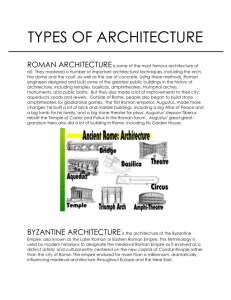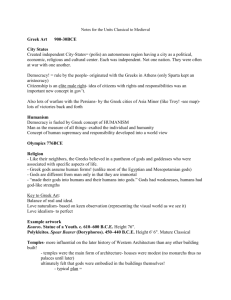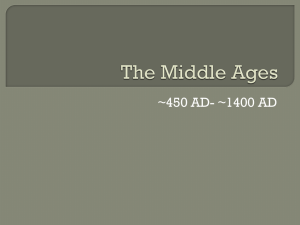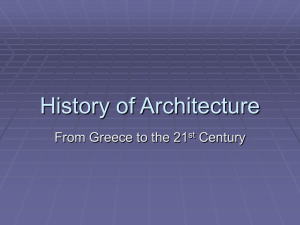Ancient Architecture
advertisement
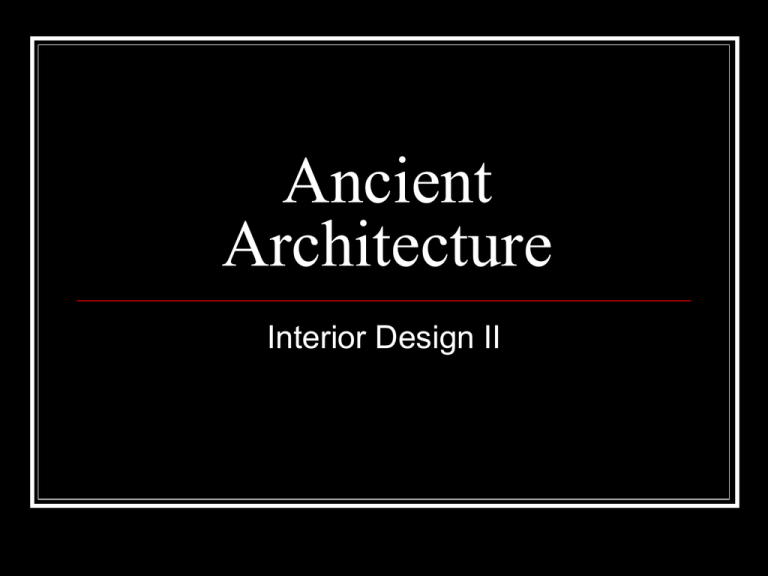
Ancient Architecture Interior Design II Egyptian 3000 BC to Roman period Funerary Buildings – Created for Monarchs & Nobles Stepped Design Granite, limestone, and sandstone - Both sun-dried and kiln-dried bricks were used extensively Hieroglyphics were decoration as well as records of historic events. Egyptian Temples Columns/Colonnades (post & lintel) First stone capital = papyrus flower Nile floods deposit fine clay, allowing ceramic arts to develop early Sandstone, limestone, & granite available for obelisks, sculpture, and decorative uses. Ramps – build on the way up, decorate as it’s taken down Mesopotamia – Babylon, Assyria, Persia Planned city building, cobblestone streets, and architecture itself have their beginnings here Mud brick on a raised plinth (platform base) Walls are ornamented on the outside with alternating pilasters and recesses Flat roofs, supported on palm trunks, (assumed) Ziggurat Mesopotamia Saddam’s Palace Ishtar Gate Greek The temple is the best known form of Greek architecture. These biggest and most beautiful buildings reflect the importance of religion. The political purpose - to celebrate civic power and pride. Beauty lies in ratios & proportions = The Golden Mean The Greeks developed three architectural systems, called orders, each with their own distinctive proportions and detailing. Doric The Doric style is sturdy and the capital is plain. This style was used in mainland Greece and the colonies in southern Italy and Sicily. Ionic The Ionic style is thinner and more elegant. Its capital is decorated with a scroll-like design (a volute). This style was found in eastern Greece and the islands. Corinthian The Corinthian style is seldom used in the Greek world, but often seen on Roman temples. Its capital is very elaborate and decorated with acanthus leaves. Greek Buildings were usually a cube or a rectangle made from limestone which was cut into large blocks. Marble was readily available. It was used mainly for sculptural decoration, only used as structural in the very grandest buildings of the Classical period. Etruscans 700 B.C. – 280 B.C. (Fall of Rome) Palaces, public buildings, and early temples made of wood and brick, so nothing remains. The Etruscans also built aqueducts, bridges, and sewers which were built so well they still exist today. Etruscan Etruscans are credited with the true stone arch Etruscan architecture was really the beginning of Roman architecture. Roman Roman art and architecture shaped by extensive borrowing, first from Etruscans, then from Greece. One architectural technique that came into use by experimentation was the arch and vault. Roman To support the tremendous weight of the arches, it was necessary to transmit the force of gravity from the top of massive piers to the foundation of the arch. The Romans achieved this feat through the use of the Keystone block. Roman Circular structures were common as well, exemplified by the Temple of Vesta, the Pantheon and the Castel Sant'Angelo. Roman The word "arena" is Latin for sand. Sand was spread across the amphitheater fighting floor to soak up blood. Early Christian Early Christian builders adapted structures that had long been used in the Hellenistic and Roman worlds. (recycled buildings) Adistinct emphasis was placed on the centralized plan, which was of round, polygonal, or cruciform shape. Early Christian Developed from Roman secular basilica Rectangular space separated by two rows of columns making a nave and two side aisles Separated clergy from congregation Byzantine A continuation of Roman and early Christian architecture. Eventually combined architecture of the near east, with the Greek cross plan for the churches. Byzantine Brick replaced stone, mosaics replaced carved decoration, and complex domes were erected. Ancient America - Mayan Monumental construction Buildings erected on platforms Upper walls decorated with continuous frieze Lime stucco painted vivid colors Mayan Every day dwellings were rectangular Two doorways were placed directly opposite each other to allow for the free flow of air. Romanesque Romanesque is characterized by a use of round or slightly pointed arches, barrel vaults, cruciform piers supporting vaults, and groin vaults. The great carved portals and church facades Stone sculpture seems reborn in the Romanesque. Romanesque Romanesque seems to have been the first pan-European style since Roman Imperial Architecture and examples are found in every part of the continent. Merchants, nobles, knights, artisans, and peasants crossed Europe and the Mediterranean world for business, war, and religious pilgrimages, carrying their knowledge of what buildings in different places looked like. Gothic Originating in northern France (Denis) in the twelfth century, Gothic spread rapidly across the continent and England, then invaded Scandinavia, confronted the Byzantine provinces. Made appearances, under the aegis of crusader and explorer in the Near East and the Americas. By 1400 it had subsumed many types of structures. Gothic There is no fixed set of proportions in the parts, and no standard relationship between solid and void. The result is a distortion. Gothic Light, open and aerial. Emphasizes verticality Features almost skeletal stone structures Great expanses of glass (stained) Sharply pointed spires Flying butresses Ribbed vaults Pointed arches Inventive sculptural detail Renaissance Rebirth of classical art and learning Classical orders, round arches, and symmetrical composition The golden mean Renaissance The ideals of art and architecture became unified in the acceptance of classical antiquity and in the belief that humanity was a measure of the universe. The rebirth of classical architecture, which took place in Italy in the 15th century and spread in the following century through Western Europe, terminated the supremacy of the Gothic style. Chinese Simple, rectangular, low-silhouetted buildings Stone and brick for permanent structures Wooden frameworks on platforms with nonbearing screen walls India All surviving architecture is stone Post and lintel, brackets and corbels Rhythmical multiplication of pilasters, cornices, moldings, roofs, and finials Overgrowth of sculpture decoration Japanese Exclusively timber Strong Chinese influence Pavilion structures with nonbearing walls Tiled, hipped roofs are widely projecting and upward turning. Garden References: http://architecture.about.com/library/bl-babylon.htm http://archnet.org/library/sites/ www.earchinfo.com/architecture/egyptian.htm http://encarta.msn.com/encyclopedia_761554529/Renaissance_Art_and_A rchitecture.html http://www.faculty.fairfield.edu/jmac/meso/meso.htm http://www.greatbuildings.com/ http://www.historyforkids.org/learn/romans/architecture/etruscans.htm http://www.historylink101.com/lessons/art_history_lessons/greek_architect ure.htm http://www.lookeducation.com/ancient-architecture-mesopotamia.html http://www.museum.upenn.edu/new/worlds_intertwined/etruscan/architectu re.shtml http://web.kyoto-inet.or.jp/org/orion/eng/hst/hist.html http://en.wikipedia.org/wiki/Greek_architecture
